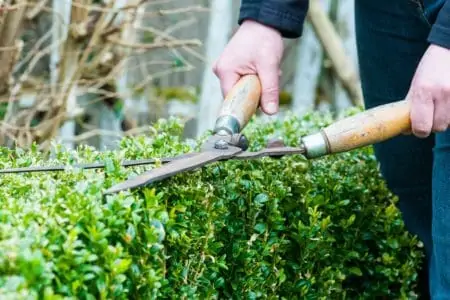If your yard is littered with leaves, what’s the best way to get rid of them? Should you rake them? Leaf blow them? Or something else?
We’ll talk through all the reasons why you should rake leaves. But we’ll also touch on when you shouldn’t rake leaves, as well as covering some other important questions on the topic.
Key Takeaways
- Rake leaves to prevent grass damage, reduce bugs, and avoid snow mold diseases.
- Wait to rake until leaves are crunchy or a thick layer has formed.
- Leaves can be used as natural mulch or compost, but avoid putting them in landfills.
- Mowing over a thin layer of leaves is an alternative to raking.
Is It Necessary to Rake Leaves?
It’s technically not absolutely necessary, but it is important. If you don’t rake at least some of them up, then you could ruin your grass for the rest of the year. Leaves that stay on the ground through fall and winter can prevent growth in spring (1).
Another reason to rake the leaves is that if you don’t, you might find yourself facing snow mold diseases.
Lastly, more leaves bring more bugs. And what happens when you have excess bugs in the yard? They eventually make their way into the house. Yuck.
When Should You Rake Leaves
Here are the best times and situations to rake your leaves:
- It’s a good idea to wait until the leaves are crunchy. So you don’t need to rake as soon as they fall down. In fact, waiting a while can protect the soil in the meantime.
- Once you have a thick layer of leaves. Even if the leaves aren’t crunchy yet, it’s time to rake them up if they’re literally everywhere. Once they start piling up, you prevent the grass from getting sun and moisture.
- If you are planning on mulching or mowing the leaves, but the layer is too thick, rake some up first to avoid damaging your power tools.
- If you are planning on showing off your yard, then you may want to consider raking up those leaves. It makes a yard look very nice and tidy. On the other hand, some people like the look of fallen leaves — strong fall vibes.
What to Do With the Leaves
Once you’ve raked the leaves into nice piles — what’s next?
You have a few options.
First, you could cut them up using a power tool or ripping them by hand. From there you could put them in a plant or flower bed to provide leaf cover. This is natural mulch and fertilizer. We recommend putting them in places that don’t get leaf cover, so the ground and soil can benefit.
You could also compost your leaves. Check with your local authority that this is an option.
Don’t
You shouldn’t put the leaves in plastic bags and put them in the landfill. This is bad for the environment. If everyone did that, it would amount to a lot of garden waste in landfills.
When Not to Rake Leaves
Can you get away with not raking leaves? Yes, in these situations:
- If it’s not urgent, and you want a chill day, relax. Take it easy. Don’t rake. Unless a thick layer of leaves has been lying there for ages, you can get away with procrastinating another few days.
- If the leaves are freshly fallen. You want to give the leaves time to provide the grass and soil with the right nutrients first. Also, animals survive on the fallen leaves, so leave them for a few days before raking them up.
- If you have a lawnmower. You could just mow over the thin layer of leaves instead of raking them. Simply leave the scraps on the ground. The small parts are fine to live on the grass, so you never need to rake again!
FAQs on Raking Leaves
Turn Over a New Leaf
If you’re sick of raking leaves every fall, you may be in luck. You really don’t need to rake all that often, and there may be some ways around raking at all.
Only rake the leaves if the trees are almost done shedding, if the layer of leaves is too thick, or once the leaves are crunchy.
The bottom line is you can leave the leaves if the layer isn’t too thick. On the other hand, if you have a thin layer of leaves, you can mow over them instead of raking at all!












